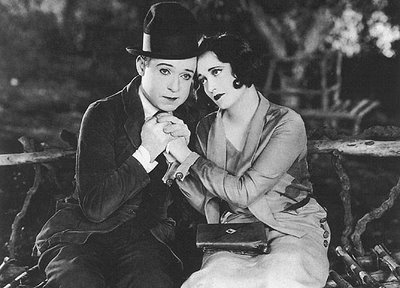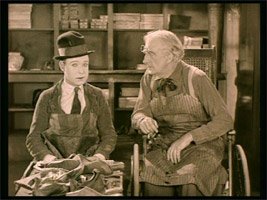 Tramp, Tramp, Tramp (1926)
Tramp, Tramp, Tramp (1926)Director: Harry Edwards
In the pantheon of silent film clowns led by the Big Three--Chaplin, Keaton, and Lloyd--Harry Langdon is barely remembered. Yet in his time, his popularity was equal to the Big Three, and he made some timeless classics. He was the first silent clown to whom I was drawn when I first started watching shorts from this bygone era on a PBS series called "The Toy that Grew Up." I was instantly captivated by his babyfaced sweetness as he negotiated peril after peril to reach his happy ending.
Langdon, a major vaudeville star, first made an impact on the silver screen in Mack Sennett shorts as the innocent man-child character created for him by Frank Capra, then a writer. This character went straight to the hearts of moviegoing audiences and propelled Langdon to stardom. He formed his own production company and inked a six-picture deal with First National. The three features he created with Capra under this deal, including Tramp, Tramp, Tramp, rival the best of the films of the Big Three.
In
 Tramp, Tramp, Tramp, Langdon plays Harry Logan, the son of a broken-down cobbler named Amos Logan (Alec B. Francis) who is on the verge of eviction from his shop. He can't compete with Burton Shoes, a corporation whose nationwide billboard campaign is driving independent shoemakers out of business. Even as Amos finagles an extra three months' occupancy out of his landlord and sends Harry off to raise the rent money, John Burton (Edwards Davis) is unveiling a new publicity stunt to cement his stranglehold on the American market. He has invited champion race walkers from all over the world to compete for a $25,000 prize by walking across the United States wearing Burton Shoes.
Tramp, Tramp, Tramp, Langdon plays Harry Logan, the son of a broken-down cobbler named Amos Logan (Alec B. Francis) who is on the verge of eviction from his shop. He can't compete with Burton Shoes, a corporation whose nationwide billboard campaign is driving independent shoemakers out of business. Even as Amos finagles an extra three months' occupancy out of his landlord and sends Harry off to raise the rent money, John Burton (Edwards Davis) is unveiling a new publicity stunt to cement his stranglehold on the American market. He has invited champion race walkers from all over the world to compete for a $25,000 prize by walking across the United States wearing Burton Shoes.As the contestants assemble at Burton's East Coast factory, Harry unwittingly is drawn into the race by the imperious world champion Nick Kargas (Tom Murray), who commandeers Harry to carry his luggage. Burton's daughter Betty (Joan Crawford), whose image on the popular billboard has won Harry's heart, sees Kargas heap abuse on Harry. She brings Harry the shoes and jersey he needs to enter the race and urges him to compete, promising him a date in California at the end of the walk. A thoroughly smitten Harry signs on.
 Among the wonderful bits in this energetically paced film is the double-take Harry does when he turns away from the image of Betty he has been mooning over only to see the real Betty, dressed exactly as she is on the billboard, trying to catch his attention. He becomes incredibly shy, running away from her, then coming close again, then running away. He acts like a 3-year-old boy. We should be annoyed with him, but we aren't. Langdon is so sincerely bashful that he charms us as well as Betty. And anyone who has the heavy-browed, Mommie Dearest picture of Joan Crawford in their head will find her unrecognizable as the beautiful, sympathetic ingenue who falls for Harry in this picture.
Among the wonderful bits in this energetically paced film is the double-take Harry does when he turns away from the image of Betty he has been mooning over only to see the real Betty, dressed exactly as she is on the billboard, trying to catch his attention. He becomes incredibly shy, running away from her, then coming close again, then running away. He acts like a 3-year-old boy. We should be annoyed with him, but we aren't. Langdon is so sincerely bashful that he charms us as well as Betty. And anyone who has the heavy-browed, Mommie Dearest picture of Joan Crawford in their head will find her unrecognizable as the beautiful, sympathetic ingenue who falls for Harry in this picture.Another charming comic scene has a farmer complain to two police officers that someone is stealing his fruit. Of course, it is Harry, who has fruit stains all over his face and a bag of fruit bulging under his oversized jersey. As he tries to evade exposure as the thief, he moves the fruit behind him. This allows the head of a chicken he also has filched to poke through a hole in the jersey. I was helpless with laughter as Harry tries to hide the curious chicken. When next we see Harry, he is working on a chain gang. Don't ask about the illogic of this turn of events within the context of the race--the gags in this sequence are just too good.
One gag that equals Harold Lloyd's seemingly death-defying stunts occurs when Harry tries to outrun some policemen who are trying to return him to the chain gang from which he has escaped. He runs through a flock of sheep and scales a fence that is built right at the edge of a cliff. As he lowers himself over the fence, his jersey gets caught on a nail. He frees the material, only to find his belt hooked as well. As he starts to unbuckle the belt, he chances to look behind him at the sheer drop below. He gingerly rebuckles his belt, pulls a hammer from his voluminous pants, pulls nails out the fence, and nails his sweater to the wood. Of course, as he pulls nails out, he is disassembling the fence, and ends up tobaggoning down the side of the cliff to safety. The scene is hilarious and thrilling in the same way as Lloyd's high-wire stunts.
Naturally, Harry wins the race and Betty. The final sequence of the film is the capper to Harry's man-child persona. The now married and prosperous Harry and Betty look in on their baby. Of course, it is Langdon dressed in a bonnet and playing in a cradle. His impersonation is perfect, from the quick tears to the awkward playing with his own hands. This scene shows the true power of the character Harry Langdon perfected. Although his career went into decline through some bad choices, causing him to fade from view in the decades that followed, Langdon was a noble clown who deserves to be discovered by a whole new audience. l


1 Comments:
At 8:15 PM, Anonymous said…
Anonymous said…
Harry Langdon is barely remembered today, but he was the toast of the silent screen in 1926.
That year, he appeared in two riotously funny feature films: "Tramp, Tramp, Tramp," which Ferdy has nicely distilled for us, and "The Strong Man," which some critics insist is Langdon's best film ever.
Harry had Frank Capra as one of his gag writers, and chose Capra to direct him in "The Strong Man." Good move. But they parted ways after the next Langdon/Capra collaboration, "Long Pants" (1927), and Harry was barely heard from again.
Post a Comment
<< Home